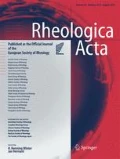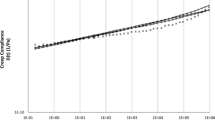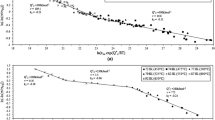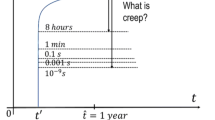Abstract
A new method is proposed for the calculation of discrete retardation spectra from creep and recovery data. The calculation of the spectrum is not restricted to a special region of consistency, e.g., the terminal region. In a retardation time window which has to correspond to the time window of the original data set a spectrum can always be calculated. A linear regression technique is applied to the measured data in the iterative calculation of a spectrum with a logarithmically equidistant spacing of retardation times. In this way the number of retardation times is limited and problems with ill-posedness are avoided. In order to obtain only positive retardation strengths it is necessary to shift the set of prescribed logarithmically equidistant retardation times on the logarithmic time scale. It can be shown that there is a retardation time interval for this shift, in which the retardation times may be varied without obtaining negative retardation strengths. While varying the retardation times in this interval the relative error of description of the data passes through a distinct minimum. In this way a spectrum is obtained which best describes the input data. Generally, one retardation time per decade will be sufficient to describe the data within the limits of experimental error. In the case of noisy data, the method is shown to work just as well and leads to a smoothing of the original data set. The method may be used for the conversion of creep and recovery data to storage and loss compliance. The error connected with this procedure is discussed.
Similar content being viewed by others
References
Baumgartel M, Winter HH (1989) Determination of discrete relaxation and retardation spectra from dynamic mechanical data. Rheol Acta 28:511–519
Baumgartel M, Winter HH (1992) Interrelation between continuous and discrete relaxation time spectra. J NonNewt Fluid Mech 44:15 – 36
Boltzmann L (1876) Sitzb Kgl Akad Wiss Wien 2 Abt 70:725
Cost TL, Becker EB (1970) A multidata method of approximate Laplace transform inversion. Int J Num Methods in Engg 2:207
Elster C, Honerkamp J, Weese J (1991) Using regularisation methods for the determination of relaxation and retardation spectra of polymeric liquids. Rheol Acta 31:161–174
Elster C, Honerkamp J (1989) Modified maximum entropy method and its application to creep data. Macromolecules 24:310 – 314
Emri I, Tschoegl NW (1992) Generating line spectra from experimental responses, Part 1: Relaxation modulus and creep compliance. Rheol Acta 32:311–321
Ferry JD (1980) Viscoelastic properties of polymers, 3rd ed., J. Wiley, New York
Ferry JD, Williams ML (1952) J Colloid Sci 6:347
Friedrich Ch, Hoffmann B (1983) Nichtkorrekte Aufgaben in der Rheometrie. Rheol Acta 22:425–434
Honerkamp J (1989) Ill-posed problems in rheology. Rheol Acta 363:371
Kaschta J (1991) Zum Nachgiebigkeitsverhalten amorpher Polymere im Glas-Kautschuk-LJbergang. Thesis, Erlangen
Kaschta J (1992) On the calculation of discrete retardation and relaxation spectra, in: Moldenaers P, Keunings R (eds) Theoretical and Applied Rheology, Vol 2, p 155, Elsevier, Amsterdam
Kaschta J, Schwarzl FR (1994) Calculation of discrete retardation spectra from creep data — II. Analysis of measured creep functions. Submitted to Rheol Acta
Malkin YA (1990) Some inverse problems in rheology leading to integral equations. Rheol Acta 29:511–518
Schapery RA (1962) Approximation methods of transform inversion for viscoelastic stress analysis. Proc Fourth US Nat Congr Appl Mech 2:1075
Tanner RI (1968) J Appl Polym Sci 12:1649
Tschoegl NW (1971) A general method for the determination of approximations to the spectral distributions from dynamic response functions. Rheol Acta 10:582–594
Tschoegl NW (1971) A general method for the determination of approximations to the spectral distributions from transient response functions. Rheol Acta 10:595 – 600
Tschoegl NW (1989) The phenomenological theory of linear viscoelastic behaviour. Springer, Berlin
Schwarzl FR, Staverman A (1952) Higher approximations of relaxation spectra. Physica 18:791–799
Schwarzl FR (1969) The numerical calculation of storage and loss compliance from creep data for linear viscoelastic materials. Rheol Acta 8:6–17
Schwarzl FR (1970) On the interconversion between viscoelastic functions. Pure and Appl Chem 23:219–234
Schwarzl FR (1975) Numerical calculation of stress relaxation modulus from dynamic data for linear viscoelastic materials. Rheol Acta 14:581–590
Schwarzl FR (1989) Viscoelasticity, in: Mark HIT (ed) Ecyclopedia of polymer science and engineering 2nded, Vol 17, p 637. J. Wiley, New York
Yasuda G, Ninomiya K (1966) Proc Japan Rubber Association 39:81
Author information
Authors and Affiliations
Additional information
Dedicated to Prof. Dr. R. Bonart on the occasion of his retirement.
Rights and permissions
About this article
Cite this article
Kaschta, J., Schwarzl, R.R. Calculation of discrete retardation spectra from creep data — I. Method. Rheol Acta 33, 517–529 (1994). https://doi.org/10.1007/BF00366336
Received:
Revised:
Issue Date:
DOI: https://doi.org/10.1007/BF00366336




